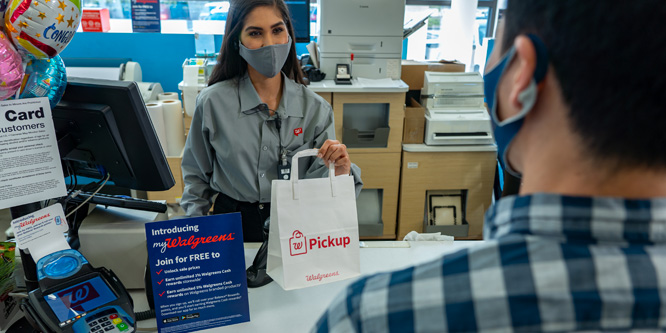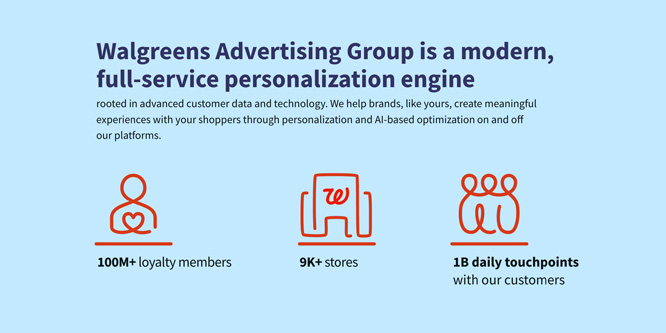
Photo: Walgreens
December 7, 2020
Is Walgreens’ first-party data a good match for advertisers?
Walgreens has rolled out its first advertising network, promising first-party data insights into more than 100 million members of the MyWalgreens loyalty program.
WAG (Walgreens Advertising Group) promises advertisers the ability to:
- Tailor audiences: “Develop one-to-one customer experiences and reach custom audiences through our advanced analytics, modeling capabilities and foundation of technology.”
- Connect with shoppers: “With Walgreens customers matched to offsite platforms like our Walgreens DSP, Facebook, Pinterest and YouTube, you can reach your brand shoppers in the digital ecosystem at an unparalleled scale. Plus you’ll have access to advertising across our owned channels, including our website, 5-star rated app and email database.”
- Boost returns: “Optimize your media spend and ROI through closed-loop measurement and channel transparency. We also offer daily SKU level transaction-based optimization and in-campaign reporting through the Walgreens DSP.”
Epsilon supports a demand-side platform for Walgreens’ service that enables advertisers to programmatically purchase digital ad inventory, while the chain has partnered with Adobe and Microsoft to present media buyers with access to customized audience segments.
“We have an unparalleled insight into consumers’ needs and shopping preferences when it comes to health and wellness items and everyday needs,” said Luke Kigel, VP, Walgreens integrated media and head of WAG. “Leveraging advanced technology to unlock the power of our first-party data, we can help brands accelerate ROI by delivering relevant and personalized experiences to their highest value consumers.”

CVS and Home Depot launched their first networks earlier this year, joining Walmart, Target, Best Buy and Kroger in making bigger advertising pushes over the last year. Amazon.com has become the third-largest digital advertising platform due to the allure of first-party data and as alternatives are sought to Google and Facebook.
“The ad industry is starting to wean itself off traditional targeting and metrics programs in the face of changes in privacy laws that are forcing online platforms, like the Google Chrome web browser, to withdraw support for measurement tools such as third-party cookies,” wrote Ronan Shields for Adweek. “The inherent value of first-party data is clear: rather than rely on outside tech companies, companies from retailers to online publishers own the consumer information that is gleaned from consumers visiting and registering on their sites.”
- Walgreens Introduces Walgreens Advertising Group (wag), a New Advanced Data and Technology-led Retail Media Offering for Brands to Deliver Personalized Experiences to their Best Shoppers – Walgreens/Business Wire
- WAG – Walgreens
- Say Hello to Walgreens Advertising Group, the Latest Retail Media Network – Advertising Age
- Say Hello to Walgreens Advertising Group, the Latest Retail Media Network – Adweek
- Walmart rolls out self-serve ads – RetailWire
- Can Walmart beat Amazon, Facebook and Google at the online ad game? – RetailWire
Discussion Questions
DISCUSSION QUESTIONS: What do you think of the potential appeal to the advertising community of Walgreens’ new advertising network? Will providing access to first-party data make advertising a meaningful revenue stream for a wide range of retailers?
Poll
BrainTrust
Paula Rosenblum
Co-founder, RSR Research
Chuck Ehredt
CEO, Currency Alliance
Recent Discussions







First-party data from Walgreens’ loyalty and customer base offers advertisers more targeted audiences with greater insights into customer buying habits and shopping preferences. With several other big retailers already doing this, it seems like this might become a privacy issue with customers, especially for medical illness related purchases that should be private.
This data needs to be treated with a very large grain of salt. We know that drug shoppers (outside of prescriptions) are not overly loyal, which means you’d be making decisions on very incomplete data. The data also skews older as younger people are less likely to need prescriptions. My advice – either find a better tool or, if you find this offering compelling, test its impact before investing heavily.
Oh, I don’t think this is a good idea at ALL. If it doesn’t break any existing laws, it will certainly generate an environment where one gets passed.
If I were Walgreens, I might concentrate more on its declining customer service and increasing medicare prescription program costs. I really liked the company and switched from CVS. Now, I’m gonna go mail order.
A couple of hints:
I haven’t actually been in a store for months — but just being at the drive-up and having to ask the pharmacy tech to put her mask on took me over the edge enough.
From Walgreens’ perspective, they are trying to monetize their first-party data. But they have to be careful if that means more ads and a more intrusive in-app experience.
From brands’ perspective, Walgreens represents yet another channel. For brands that sell mostly or exclusively at Walgreens, this would be a must-have channel. For brands that sell beauty, cosmetics and over-the-counter products, this could fill some gaps in their customer understanding.
With cookies disappearing, this type of network collaboration has huge potential for growth. Walgreens in particular has higher frequency with many of their customers than the grocery store – across a wide array of product categories. Therefore the insight they have about customer segments will make the Walgreens network very compelling to a large audience of advertisers (if it works).
Of course, Walgreens can increase the dimensions of each customer profile if they are also tracking conversion with the advertisers and build a close enough working relationship to know what else customers are buying (which Walgreens may not sell – but still helps define lifestyle preferences).
There is a very good reason major retailers are all scrambling to provide their own “first-party data” analytics — they are an untapped profit center for the retailer. Like most data systems, they can provide valuable insight and access to consumers when used the right way by the right brands. But all brands feel pressure from retailers to use their systems, often pushing “utilization targets” and other forms of quotas onto buyers for supplier participation. In the end, most suppliers do the minimum necessary to maintain distribution and receive little to no real return for their spend. You can argue that it’s not the retailer’s fault if the customer doesn’t use what they buy effectively. And the value offered by retailers today is much improved versus earlier advertising offerings. But it only works if you have the resources to use it and the shopper spend dollars to implement effective programs to reap those returns.
Conflicts aplenty! Brands are pitted against one another internally within the new Walgreens advertising network. Walgreens becomes the new hall monitor dolling out “first party” data through the filter of corporate bias based on what is best for Walgreens’ financial outcomes. As a consumer, for years the in-store Walgreens experience has been robotic. Not to mention, Walgreens’ in-store pricing strategy is highly frustrating, demanding customers take the time to do the math to determine what is the best in-store price that day on almost every product in the store! Walgreens is a modern, full-service Walgreens personalization engine serving its client, Walgreens.
With the end of third-party cookies online looming in the background, brands are desperate for more first-party data sources to fill their advertising needs, especially seeing what success they have had on marketplaces like Amazon’s. Retailers like Walgreens also see the wild success Amazon has enjoyed with their advertising programs and naturally want to leverage the massive customer data they have collected as a new revenue center, just as they’ve watched Target, Walmart, and Home Depot launch something similar. The issue is, at what point will consumers and regulators say enough is enough? There are plenty of large retailers that could implement such programs and the likes of Adobe and Microsoft (and most likely Google and Facebook) will be thrilled to help them. From a purely business perspective, it makes sense for retailers to do this and for brands to leverage these resources. But I expect at some point consumers will reach a breaking point as this will no doubt increase the number of ads consumers see and the more targeted and personalized they become, the more likely consumers will want to revolt against them.